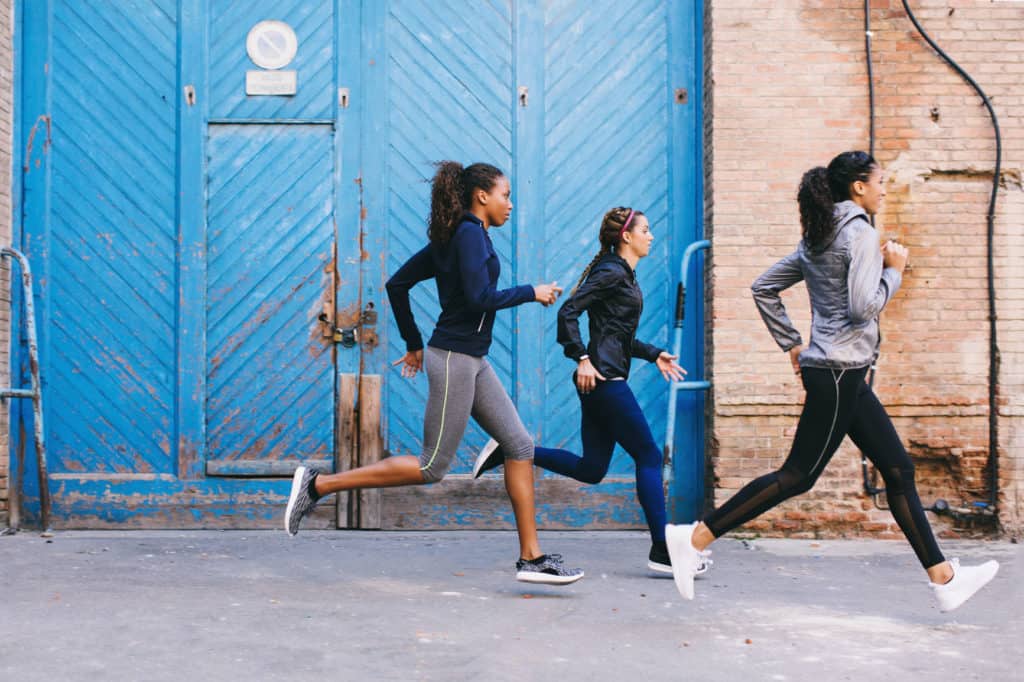
Intermittent fasting and sport
Intermittent fasting and sports have become increasingly popular in recent years. It’s no wonder: if you want to work effectively on your fitness goals, a combination of healthy eating and regular exercise is crucial. But what about physical activity during interval fasting? When should you exercise during fasting, and at what intensity? We spoke with fasting experts Lydia Löser and Stella Heuer of Kale&Me to answer this.
Find out how interval fasting and sports can work together, what the pros and cons are, and what tips you should follow for successful training as an athlete during fasting. Pssst: You can also win a little something. So it’s best to read to the end!
We generally recommend that you seek medical advice when changing your diet. Every body is different and therefore reacts differently. This article serves only as an informative basis and does not replace professional care.
What is intermittent fasting?

First of all, intermittent fasting is not a diet. With typical diets, often only short-term successes can be achieved. The discipline usually ends as soon as the diet is over and old habits return. With intermittent fasting, it is possible to reduce or maintain weight in the long term and optimize your health. Intermittent fasting is about scheduling periods of no food intake into your daily routine. Doing so makes you consciously put your body in a state without caloric intake. The goal of intermittent fasting is to reduce fat while protecting or even increasing muscle mass. The “intermittent” means that you only interrupt food intake and do not abstain from calorie intake for too long. Various studies show that intermittent fasting supports the immune system, protects the cardiovascular system, stabilizes insulin levels, and thus can help with weight loss and may even slow down the aging process through stimulation of autophagy. Strength athletes and bodybuilders use the method to lose fat efficiently while losing as little muscle mass as possible. Another advantage is that “intermittent fasting” is much easier to implement than diets. So you have enough power and strength to train intensively despite the fasting period.
What methods of fasting exist?
There are several forms of interval fasting, with the following two being the most popular: the 16:8 method and the 5:2 method. We’ll give you a brief overview of daily and weekly fasting.

Daily fasting: Interval fasting
The best-known and most popular method of interval fasting is the 16:8 method. Here, there are 16 hours between the previous day’s last meal and the new day’s first meal. You usually eat two meals in the 8 hours you are allowed to eat. However, there are other variations of intermittent fasting. For example, you can also fast for 14, 18, or 20 hours a day and then eat in the remaining 4 to 10 hours. Several apps like fastic help you track your process.
Weekly fasting: Intermittent fasting
Two well-known variations for intermittent fasting, or weekly fasting, are the 5:2 method and the 6:1 method, which Kale&Me also support with their juices. In the 5:2 method, you eat normally five days a week and nothing on two days. With the 6:1 method, it’s the same principle, except that you eat normally for six days and then fast one day.
How exactly does the 16:8 method work?
As you’ve already read, “16:8” stands for the two periods in which you fast and eat. 16 hours of no food intake is followed by 8 hours of eating.
During the 8 hours, you eat a predefined amount of macronutrients (protein, carbohydrates, and fat) that correspond to your basal metabolic rate or your target goals. The 16-hour fasting phase follows the 8-hour calorie intake phase.
Specifically, in the 16:8 fasting method, you put your entire caloric needs into 8 hours.
During this time, you consume all the macronutrients you need. In the 16 hours after that, you drink coffee and tea without sugar and milk and/or water, of course.

A timing example: you fast from 7 p.m. to 11 a.m. and consume all calories between 11 a.m. and 7 p.m. Of course, you can shift this time window depending on your daily routine and desires – but keep the 16:8 split.
Most 16:8 fans, however, skip breakfast. Try out how it works best for you personally. You don’t have to do the two phases “forever,” but you can also go back to your usual food intake or vary the time windows.
Can I do sports while fasting?
Yes, absolutely! In fact, intermittent fasting combined with exercise can be especially effective in achieving your fitness goals – building muscle or increasing endurance.
Possible benefits of intermittent fasting
Below are some of the most significant benefits of intermittent fasting for athletes and general health.
Improved fat-burning and weight regulation

If your goal is to regulate your weight, interval fasting can help increase your metabolism. Fasting empties your carbohydrate stores. So once you exercise, your body no longer reaches for it, taking fat tissue as the next available energy source. In addition, increased epinephrine (adrenaline) rejects have been found in some studies, which can increase your willingness to perform. In short, interval or intermittent fasting increases caloric expenditure and decreases caloric intake as long as you eat less during the eating phase than you would without intermittent fasting – for example, by skipping a meal. Fasting experts Lydia and Stella of Kale&Me even report additional fat burning when combined with endurance exercise.
Improved muscle building

Many studies speak of an increased level of the human growth hormone thanks to intermittent fasting. Fasting is said to increase the hormone up to five times. The increase in this hormone, in turn, helps burn fat, build muscle, and generally improve health.
Increased endurance
If you work primarily on your cardio, you know the most important thing for your endurance is getting oxygen to the cells you need. One study shows that interval fasting can significantly increase your maximum oxygen uptake through exercise compared to people who ate before exercising.

Other health benefits
- Insulin and blood sugar decrease, which is especially beneficial for people at risk for type 2 diabetes
- Exercise especially combined with intermittent fasting, stimulates autophagy, a cleansing and recycling process at the cellular level, which is important to prevent skin aging and diseases such as cancer, Alzheimer’s, or Parkinson’s disease
- It helps with cell repair and cell rejuvenation through more mitochondria
- Better training effect due to more energy
- Increased resistance to oxidative stress
- It helps detoxify the body
Possible disadvantages and side effects of interval fasting
Lydia and Stella from Kale&Me also talk about possible side effects “Weight training in the middle of the fasting phase, without subsequent food intake, can inhibit your training effect and muscle building, respectively. Also, in the first few weeks of switching to intermittent fasting, you may feel less energy during the fasting phase. However, this will subside after you get used to it. If you do not follow a nutrient-rich diet during the meal phases, you may not take in enough nutrients to best support your training. Therefore, you should always eat a nutrient-dense, whole-food, balanced diet. Also, if you combine interval fasting with exercise during the fasting phase, you may experience fatigue and/or long-term lack of training effects if your workouts are too intense.”
Intermittent fasting and sport

In general, interval fasting and sports can be combined well. It can even bring some advantages. But here again, we would like to emphasize: Always listen to your body’s signals. You should be aware of them and pay sufficient attention to them. Also, always make sure to drink enough fluids.
Fasting and sports – is it healthy?
You have already read that intermittent fasting can have many health benefits. One possible reason for this could be that the human body is evolutionarily adapted to periodized food intake. If we eat a lot of carbohydrates, the insulin released helps transport energy into the cells (by the way, carbohydrates also bring other accompanying substances, such as protein, into the cells). In fasting mode, the body draws on energy already in the body, including protein, glycogen, blood sugar – and of course, fat!
The idea is that keeping insulin levels low (in phases) stimulates fat burning. This is why fasting works. Intermittent fasting, according to the 16:8 method, helps to ensure that the body (ideally) primarily uses fat and less of the body’s protein for energy. In other words: you lose fat but hardly any muscle mass – the dream of all bodybuilders.
What can I consume during the fasting phase?

Allowed are:
Water: It is essential to drink enough fluids. Therefore, make sure to drink enough water.
Unsweetened coffee without milk: Caffeine can further strengthen the fat-burning process. However, people with sensitive stomachs should not overdo it with a hot drink; otherwise, abdominal pain can threaten.
Unsweetened tea without milk: Green and black tea also contain caffeine and support fat burning, although one should not attach too much influence to this effect. In addition, green tea contains healthy polyphenols and more antioxidants than coffee.
“Zero” soft drinks: They are certainly not the healthiest choice, but theoretically, there is nothing against the (moderate) consumption of soft drinks with sweeteners.
What am I allowed to consume during the eating phase?

As described above, intermittent fasting is not a diet. Therefore, you do not have to give up anything for the time being. However, you should ensure you eat a balanced diet and drink enough fluids, such as water. So do not see the food phases as a free pass.
Can interval fasting improve athletic performance?
Various studies, reports, and experiences reflect positive effects on athletic performance. The right combination of interval fasting and sports can increase endurance, regulate weight better and promote muscle building. Especially the training at the end of the 16 hours shows a positive effect.
When should you do sports during interval fasting?
You probably think that you shouldn’t do any sports, especially during fasting, because you don’t eat any food. But you will be surprised! You can benefit from many positive effects if you exercise during or at the end of the fasting period. We summarize the most important benefits for you.
When to exercise during interval fasting?
When you should exercise during interval fasting depends on the intensity of the sport, your personal goals, and your daily rhythm. For example, strength training at the end of the fasting period increases muscle building.
Sport during the fasting phase

You can combine light to moderate-intensity training very well with interval fasting. This includes endurance and strength training, team sports, impact sports, dancing, yoga, and freestyle sports. With Urban Sports Club, you have a wide selection of sports partners throughout Germany in just one membership – so you’re sure to find the sport you enjoy most. Lydia and Stella confirm that you can do sports during the fasting phase. It doesn’t have to be a sweaty, overly demanding activity. Even moderate activities, such as cycling, Pilates, and brisk walking, are sufficient to achieve the benefits mentioned. Endurance training for fat-burning can also be done in the middle of the fasting phase to take advantage of the increased fat-burning effect. If you break the fast, your blood sugar level will rise, and fat burning will slow down again.
Sport at the end of the fasting phase

It is best to do your strength training at the end of the fasting phase and break the fast shortly afterwards. This way, you additionally support muscle-building and the training effect. If you want to reduce your weight, you can consciously train according to the “train-low principle” with emptied glycogen stores before breaking the fast so that a particularly intensive stimulus is set for the metabolism.
Sport during the eating phase
When exercising intensively, you should keep a few things in mind: Never exercise while fasting or on fasting days. This way, you avoid cardiovascular problems and weaker performance. According to experts Lydia and Stella, it’s better to do intense strength training, HIIT, or other high-impact sports while eating. For strength athletes with a focus on muscle building, training between meals is recommended or should be placed so that a meal is consumed after the workout.
All in all, all athletes should ensure that their protein intake is sufficient so that the body does not become over-acidic due to the increased breakdown of fat.
What should I pay attention to as an athlete during interval fasting?
Intermittent fasting can help you better control your eating patterns, improve your overall health, and optimize your athletic performance. Here are a few things to keep in mind as an athlete:
- Make sure you are in good general health, and please discuss individual questions with your doctor or expert on the subject.
- Start gently and give your body the time it needs to adjust to the new time-based concept. You can first start with 12 fasting hours and then gradually increase them.
- Find your personal rhythm.
- During the eating phases, two to three balanced meals are optimal.
- Provide your body with sufficient water or unsweetened tea without milk during the fasting phase.
- Consume the highest-calorie meal after exercise.
- The composition of nutrients depends on your personal training goal. On training days, you can consume more calories and carbohydrates, while you should keep the protein intake constant on all days.
- Always listen to your body and interrupt fasting if necessary, especially if you feel unwell or notice a drop in performance. There are people for whom it simply does not work.
Strength vs. cardio – what is the difference in interval fasting?

Interval fasting and strength training/ muscle building
Lydia and Stella from Kale&Me explain that to build muscles after a workout, the body needs a balanced meal with protein. Therefore, you should place moderate muscle training at the end of the fasting phase and intense muscle training in the middle of the eating phase.
Intermittent fasting and cardio training
Lydia and Stella recommend moderate cardio sessions during the fasting phase for cardio training. This will increase fat burning by a further amount. It is important that you put very intense cardio sessions at the end of the fasting phase or in the eating phase.
Is interval fasting suitable for everyone?
Generally speaking, there is nothing wrong with intermittent fasting for most people. According to Lydia and Stella, the good thing is that intermittent fasting is type-dependent. That means: You can place your time window in the morning or evening and adjust the hours again and again. It is okay if the number of hours is sometimes not adhered to. And don’t forget that intermittent fasting is not a diet. If the daily 16:8 method is not for you, you can try other methods, such as 5:2 or 6:1.
Who benefits from intermittent fasting?

In general, everyone who wants to do something for their health, regulate their weight in the long term, as well as athletes to improve their performance, will benefit from intermittent fasting.
Two particularly interesting aspects for athletes are optimizing fat metabolism and increasing human growth hormone (HGH), which increases muscle growth and fat burning. Thus, interval fasting benefits strength athletes because it promotes the buildup of lean body mass.
But also endurance athletes benefit from it because a proportionally higher fat metabolism activity means protection of the limited carbohydrate storage in the liver, muscles, and blood during training.
Which people should not do interval fasting?
You should be especially careful if you have cardiovascular problems, are growing, have metabolic diseases, or have other chronic conditions. Pregnant and breastfeeding women are advised not to do interval fasting. The experts Lydia and Stella recommend, with medicine-taking and/or pre-existing illnesses, intermittent fasting to always be medically clarified. Also, people with a very high-stress level, high-performance athletes, and humans with physically fastidious jobs should approach fasting with caution.
Testimonials from athletes about the effect of interval fasting on training
Lydia and Stella from Kale&Me tell us that many athletes report increased energy during the fasting phase. This is because the body is not busy digesting and utilizing food, which results in reasonably high energy expenditure. It leaves more energy for training. Some top athletes combine interval fasting and sports. By changing their diet, some have reduced their body fat percentage and improved their concentration.
Win an all-round carefree package for your fasting days!

Together with Kale&Me, we are giving away a three-week 5:2 interval fasting package. With the 5:2 method, you fast for 2 days and eat a balanced diet for the remaining 5 days. Kale&Me provides you with five juices and a broth on fasting days. You can also discover recipes and lots of little nutrition tips to help you eat healthy, delicious and nutritious food. How can you participate? Tell us in the comments below this blog article what your experience with fasting has been so far and what other questions would interest you. The deadline is February 28, 2023, at 11:59 p.m.
You can find all terms and conditions here.



Hey Natalia so what happened with the contest? Who won? 🙂
Hey Alexandra,
thank you for reaching out!
Unfortunately, you did not win this time.
We contacted the winner directly via e-mail.
We hope you will have more luck next time! 🙂
Best regards,
your Urban Sports Club Team
I have been using intermittent fasting for about five years now, starting with the 16:8 pattern and now most regularly use 18:6 or sometimes 5:2 if it suits my schedule that week. I can safely say that implementing IF was one of the best things I have done for my overall health – gone are my binge eating days; I’m healthier, happier, and more able to control my body weight and metabolism. Pair it with a regular workout routine, and you’re laughing, especially caffeine-cardio fasting.
I recommend IF to all my friends and family members, and those who’ve taken the step have experienced only sound effects. One friend has chronic intolerances to many common foods and switching up her eating habits with fasting is the simplest way she has found to alleviate these intolerances and now she actually enjoys food again.
If I had one question, it would be why isn’t intermittent fasting recommended to everyone by their doctors and health specialists, when the health benefits are so clear and numerous?
I eat a balanced diet but never paid much attention to meal times, besides trying not to go to bed with a full stomach. I’d love to give fasting a try to see how it affects my body and if it helps me attain my fitness goals and energy levels.
I’ve been experimenting with intermittent fasting for the past few months and have found it to be a game changer for my health and wellbeing. Initially, the idea of going for hours without eating seemed daunting, but once I got used to it, I found that I actually felt better when I wasn’t constantly snacking. I typically fast for 16 hours a day and eat within an 8-hour window, which means skipping breakfast and having an early dinner. At first, I felt a little hungry in the mornings, but soon I found that I had more energy and mental clarity throughout the day. I also noticed that my cravings for unhealthy foods decreased, and I was able to maintain a healthier diet overall. While it may not be for everyone, intermittent fasting has definitely been a positive experience for me, and I plan to continue incorporating it into my lifestyle.
Can intermittent fasting help boost your metabolism, and if so, how?
I used intermittent fasting after my first pregnancy in combination with a daily 20-minute exercise session and thus lost almost 18 kilos within 6 months. I made sure to eat healthy and balanced, drink a lot of water but also not to forbid myself things – but everything only in moderation according to the 80:20 method. The best decision I made to maintain a healthy lifestyle without giving up my favorite sweets and keeping the weight off.
I’ve done the 16:8 intermittent fasting and I always felt so energised and focused!
I love giving my body little breaks and detox periods as it not only helps me with my digestion and energy levels, but it also helps out with how my skin looks like.
I’d really love to try out the three-week 5:2 interval fasting package as I’m sure it will improve my gut health by far.
Thanks for the nice article 🙂
I am all in for a juicing diet. I always feel better after doing it. In 2020 after the first lockdown, i did a weekend juicing diet since I gained weight during the lockdown and i lost 4-5 Kg and even felt that the cellery juice i included in my juicing diet improved my digestion. After that I drank cellery juice every morning for one year but I stopped now for a while and i really want to go back to that routine again!
Juicing diet could be tough after 2-3 days diet, but it is worth it and I would do it again 😉
I have tried 16:8 fasting and love it just for the energy and focus it gives me. I usually do it 2 to 3 times a week and try to keep a balanced diet the other days. Question I still have is: if you do fasting many days straight, does your body get used to it and stop feeling the benefits of fasting?
I have never actually tried intermittent fasting, but will definitely try it out!
After learning about IF from the Huberman Lab podcast, I am adjusting to a daily feasting/fasting window, i.e. eating only during a set time window per day. For me this is currently between 11am and 8pm. I’d love to be able to shrink that timing but it’s also a matter of lifestyle changes! Rather than jumping right into a very strict schedule, I started with 10am and have been pushing the morning timing slowly back as I manage my energy levels and observe the benefits already – which keeps me motivated 🙂
I started intermittent fasting with the 16:8 format and soon realized that the 18:6 was very doable. I stopped snacking constantly and I feel more energized. I didn’t fast for weight loss, but rather for better focus and mental clarity. Great mood is another noticeable bonus – as is less inflammation and better overall wellbeing!
I’ve tried juice cleanse twice (3 and 2 days). Generally I feel it’s a great way to start the year. It effects me not only physically but also somehow mentally.
What I would not recommend though is to do it in winter months… Personally I felt very cold all the time and hence warmer weather seem to make the whole process more enjoyable.
And my question is: Is there any difference in the fasting effects between the 16:8 and 6:1 modell?
I’ve done intermittent fasting a while ago but found it really hard to stick to when you do not have a good routine. While it was challenging, I found it to be a rewarding experience overall. I’ve done the 16:8 where I skip breakfast and eat within an eight-hour window, and I think it has helped me to maintain a healthy weight and improved my digestion. However, I haven’t tried the 5:2 interval fasting method before. One question I have is how to manage hunger pangs during fasting days. I’ve found that staying busy and keeping myself distracted helps, but I’d love to know if there are any other strategies that could help.
I have not had experience with fasting so far, but I’d love to try and see if it gives all the benefits that everyone talks about, and also how I can combine it with my training.
Is intermittent fasting okay for people with low blood pressure?
I have had great experiences fasting for 5 days, only consuming a little bit of broth and juice. It was very valuable to experience that I actually had more energy than when eating and also mentally I felt very clear and focussed. Though I still took it easy when working out and avoiding high-intesity trainings.
The only “negative effect” was in preparation for the fasting days when I slowly reduced food and coffee intake. I was lacking focus and energy due to coffee withdrawal, that lasted for 2 days.
I am already looking forward to the next fasting, hopefully with the Kale&me package 🙂
I began intermittent fasting with just two meals in December 2019. I currently just eat one meal every day. This, in conjunction with the LCHF (low-carb, high-fat) diet.
My family is made up of obese, diabetic individuals who have had multiple heart attacks and strokes. Everyone advised me that losing weight would be difficult given my genetics.
The most significant issue is that in November 2019, I had a comprehensive blood test that revealed various metabolic issues, including a high risk of diabetes and vitamin and hormone insufficiency. In other terms, I was malnourished and fat. I’ve shed 20 kg since then.
And now for the best part: based on blood tests taken in December 2019, when I began intermittent fasting with the LCHF diet, and then again in November 2020. The diabetes findings have reduced from “Severe Risk” to “No Risk”.
I am no longer malnourished, according to blood tests. I was deficient in vitamin D, which is essential for the immune system. Magnesium and potassium are now added to the water I drink.
Additional advantages include increased energy. I’m not as fatigued anymore, and I can study twice as much as before. I read more than ever before; I sleep like a rock from 10 p.m. to 5:30 a.m. every night; and my migraine was never felt again.
My question: if I do longer fasting too often, will my body adapt to the intermittent fasting ?
I have been doing the 16:8 intermittent fasting for several years now and never felt better! It helped me with weight loss, better sleep schedule, focus and numerous other benefits. As I’m now training for a half marathon and have experienced some issues with running whilst fasting, my question is if longer runs need to be avoided whilst fasting?
Thank you!
I’ve done the 16:8 intermittent fasting schedule. I found it surprising in a way because my body did actually feel a shock and I was not expecting that. I have issues with acid reflux in my daily life and it got worse. My question is around how to mitigate symptoms of fasting, like increased acid reflux, especially in the beginning. It seems that the 5:2 fasting might be better because it’s not a daily fasting change but it also seems more advanced that 16:8. I’m also interested in how to balance alcohol and intermittent fasting.